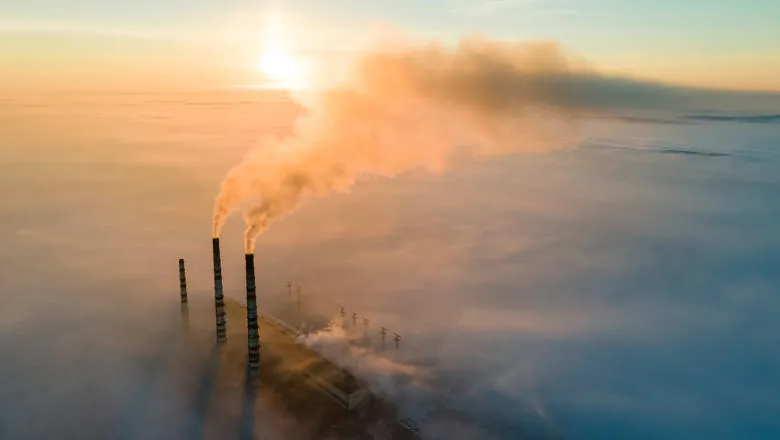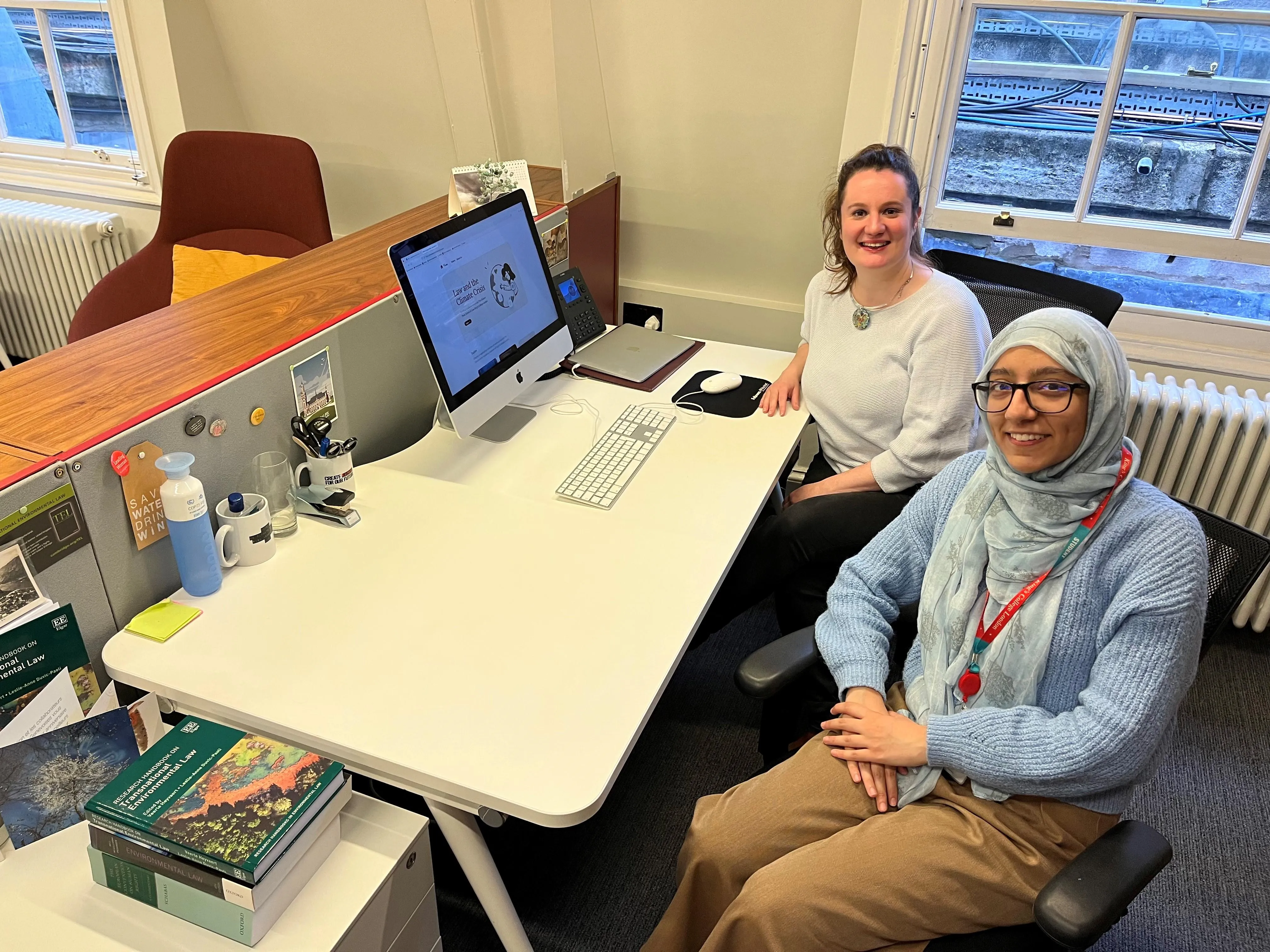A virtual exhibition entitled 'Law and the Climate Crisis' has been launched by The Dickson Poon School of Law's LLM module 'Global Law of Climate Change', which uses creative approaches to disseminate knowledge about the Climate Crisis

The climate crisis presents complex and urgent questions that require new creative approaches to help unlock the potential of law in responding to the challenge.
Law and the Climate Crisis, is a virtual exhibition that is part of the 'Global Law of Climate Change' LLM module, convened under the supervision of Dr Leslie-Anne Duvic-Paoli. We catch up with Dr Duvic-Paoli and Saira Munir, a final year LLB student and architect of the website, to hear their thoughts about the exhibition.
Can you tell us about the exhibition and how it came to life?
Leslie-Anne:
The virtual exhibition displays the creative works of students at The Dickson Poon School of Law, King's College London. These creations were designed by postgraduate students who joined the 'Global Law of Climate Change' course I convene for the LLM programme and looks at the relationship with climate change and the rule of law in a global context.
In this course, students are asked to produce a creative item that presents their research project in a way that easily communicates their findings to a public without specialist knowledge of climate law. I was inspired by a seminar organised by King's Academy, the Centre for Educational and Learning Development at King's, on assessing students through innovative methods.
The challenge to think beyond established forms of assessments such as essays or exams resonated with me, as I wanted students' learning to be enriched by an authentic task that intellectually stimulates them, makes sense of the complexity of the climate problem and empowers them to tackle this global challenge.
Students are given the freedom to present their research using a wide range of genres and media. In this exhibition, you will find a drawing on carbon sinks, a song on the just transition, a children book on climate negotiations, as well as plenty of educational material in the form of posters, podcasts and blog posts.
The exhibition came to life thanks to the creations of students and also thanks to two King's students, Caitlin MacKenzie Mannion in the summer 2022 and Saira Munir in the summer of 2023, who contributed their vision and digital skills to bring together the creations into a virtual exhibition.
Saira:
Can you tell us about your involvement in the exhibition and how you heard about it?
I initially discovered the climate law virtual exhibition project when I read the advertisement for the FLEETS fellowship (Fellowships for Law Education, Enhancement, Teaching & Scholarship). This fellowship, titled 'Teaching Climate Law Beyond the Law School', was offered by Dr Leslie-Anne Duvic-Paoli and its central objective was the creation of a virtual exhibition in the form of a website.
With my interest in studying environmental law under Dr Leslie-Anne Duvic-Paoli in the coming academic year and a passion for graphic design, I saw the fellowship as an excellent opportunity to engage in something both highly interesting and enjoyable over the summer. Overall, it was a wonderful opportunity to learn about climate change and also to consolidate my skills in graphic design and web development.

Can you explain how your project fits in with wider broader conversations in relation to advocacy on climate change or environmental sustainability and what the overall goal is?
Leslie-Anne: The climate emergency is a crisis of ideas and values, and I believe that higher education has a moral responsibility to increase awareness about the environmental crisis and facilitate social change. In recent years, public interest for climate action has increased dramatically; in this context, students have a role to play in trying to solve this crisis by sharing their knowledge with the wider public.
Saira: Indeed, the virtual exhibition serves as a platform to amplify the voices of students. Climate advocacy movements and protests for change are primarily driven by the youth of today - with our futures at stake, we're particularly incentivised to take action.
Students are also increasingly approaching climate law from a justice-oriented perspective, aiming to address the social and economic dimensions of climate change, along with the unequal impacts it imposes on vulnerable societies and nations. As I explored students' work, I found it particularly engaging to delve into topics covering the climate crisis from various angles; students researched the climate crisis through a developmental, human rights, and Indigenous rights perspective, all of bring important insight to our understanding of how law governs the climate crisis.
What do you want students taking the module to take away from the creative element of the module?
Leslie-Anne: My main objective with the creative component of the course is to transcend the confines of the classroom by bringing knowledge of, and debates about, climate law into the public sphere. I hope that the task invites students to engage with different ways of doing, and using, law and encourages them to express themselves creatively and to develop their own voice. It gives them the opportunity to contribute to crucial discussions about one of the most pressing global issues of our time.
Anything either of you would like to add?
Saira: I would like to express how immensely rewarding the entire experience of working on this project has been, and I extend my gratitude to Dr. Leslie-Anne Duvic-Paoli for providing me with the opportunity to contribute to this exhibition. Additionally, I'd like to acknowledge the groundwork laid by the previous fellow, Caitlin MacKenzie Mannion, who did an exceptional job establishing the virtual exhibition as part of the 2022 FLEETS program. Her efforts provided the foundation upon which I built this year's exhibition.
I also want to extend my thanks to the students who kindly agreed to contribute their work to the exhibition. Their work was not only insightful but also highly inspiring. I was particularly impressed by the diversity of topics and perspectives on the climate crisis that were explored. I wholeheartedly recommend anyone reading this to take the time to explore the exhibition and students work, as it covers a wide spectrum of critical issues, including the intersection of climate change with the global economy, Indigenous rights, climate justice, climate litigation, human rights in the context of climate change, energy policies, and climate science. It offers a comprehensive and eye-opening view of the challenges we face in addressing the pressing issues of our time, but the students work also help illuminate hope and change for the future.
Leslie Anne: We hope that you will enjoy the exhibition, learn something about this global challenge and feel inspired! The exhibition will continue to evolve, it will be enriched every year with the contributions of new students studying climate law. We encourage you to return regularly to explore the latest creations! Moreover, we warmly welcome feedback and ideas for collaboration: do not hesitate to reach out.
Law and the Climate Crisis is now online and open to the general public.







